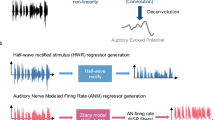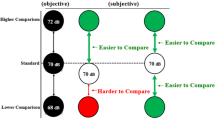Abstract
Auditory imagery occurs when one mentally rehearses telephone numbers or has a song ‘on the brain’ — it is the subjective experience of hearing in the absence of auditory stimulation, and is useful for investigating aspects of human cognition1. Here we use functional magnetic resonance imaging to identify and characterize the neural substrates that support unprompted auditory imagery and find that auditory and visual imagery seem to obey similar basic neural principles.
Similar content being viewed by others
Main
The few studies that have examined the topic of auditory imagery2,3,4,5 have focused on the neural substrates of directed imagery (for example, “imagine a tone”). What is not known, however, is whether similar principles guide the more pervasive and spontaneous forms of imagery that punctuate everyday life. We used functional magnetic resonance imaging to investigate the recruitment of auditory cortex during spontaneous auditory imagery of excerpts of popular music.
During scanning, subjects passively listened to excerpts of songs with lyrics (for example, Satisfaction by the Rolling Stones) and to instrumentals that contained no lyrics (for example, the theme from The Pink Panther). Each piece of music was pre-rated by subjects as either familiar or unknown, and a unique soundtrack was created for each individual. Short sections of music (lasting for 2–5 s) were extracted at different points during the soundtrack and replaced with silent gaps. We then monitored the neural activity in subjects that occurred during these gaps. (For details of methods, see supplementary information.)
Brain activity in the primary auditory cortex and in the auditory association cortex (Brodmann's area 22) (Fig. 1a) was compared during gaps of silence in familiar and unknown songs. The results revealed a functional dissociation within the left auditory cortex (region×music-type interaction: F[1,14]=48.92, P<0.0001; Fig. 1b). Silent gaps embedded in familiar songs induced greater activation in auditory association areas than did silent gaps embedded in unknown songs (Fig. 1b); this was true for gaps in songs with lyrics (F[1,14]=5.46, P<0.05; Fig. 1c) and without lyrics (F[1,14]=11.56, P<0.005; Fig. 1d). Moreover, when familiar songs contained no lyrics, cortical activity extended into the left primary auditory cortex (F[1,14]=22.55, P<0.0005; Fig. 1d).
a, An inflated rendering of the left hemisphere9 illustrates primary auditory cortex (PAC; red) and auditory association cortex, also known as Brodmann's area 22 (green). The superior temporal sulcus (STS) and inferior temporal sulcus (ITS) are indicated for reference. b, Signal change (arbitrary units) in PAC (red) and Brodmann's area 22 (green) during gaps in familiar songs with lyrics (FL), familiar instrumentals (FI), unknown songs with lyrics (UL) and unknown instrumentals (UI). Error bars denote s.e.m. c, d, Difference in activity, which is greater for familiar songs, during silent gaps embedded in songs with (c) and without (d) lyrics, projected on to flattened views of the left temporal lobe. Dark-grey regions represent sulci; lighter grey regions denote gyri.
We confirmed that these effects were uniquely attributable to the gaps of silence in the music, rather than simply the result of differences in activation in response to hearing different music categories. By contrast with the gap responses, listening to unknown songs produced greater activity in auditory association areas than did familiar songs (lyrics: F[1,14]=11.24, P<0.005; instrumentals: F[1,14]=31.74, P<0.0001), and activity in the primary auditory cortex did not differ as a function of familiarity (see supplementary information).
Our findings offer a neural basis for the spontaneous and sometimes vexing experience of hearing a familiar melody in one's head. Whereas previous investigations have explicitly directed subjects to imagine a specific auditory experience2,3,4, we provided no instruction. Instead, simply muting short gaps of familiar music was sufficient to trigger auditory imagery — a finding that indicates the obligatory nature of this phenomenon. Corroborating this observation, all subjects reported subjectively hearing a continuation of the familiar songs, but not of the unfamiliar songs, during the gaps in the music.
We note also that the extent of neural activity in the primary auditory cortex was determined by the linguistic features of the imagined experience. When semantic knowledge (that is, lyrics) could be used to generate the missing information, reconstruction terminated in auditory association areas. When this meaning-based route to reconstruction was unavailable (as in instrumentals), activity extended to lower-level regions of the auditory cortex, most notably the primary auditory cortex (Fig. 1b, d).
These findings parallel those in the domain of visual imagery. For example, visual imagery elicited when considering names of objects (known as figural imagery) does not rely on the primary visual cortex6,7. As these ‘low-resolution’ images do not demand fine-grained perceptual processing, activity in visual-association areas is sufficient to reconstruct the relevant representation. By contrast, when semantic information is absent or irrelevant (known as depictive imagery), a ‘high-resolution’ perceptual image is needed to reconstruct a representation, hence activity extends into the primary visual cortex8. Our results provide evidence that auditory imagery obeys the same basic neural principles.
References
Kosslyn, S. M., Ganis, G. & Thompson, W. L. Nature Rev. Neurosci. 2, 635–642 (2001).
Halpern, A. R. & Zatorre, R. J. Cereb. Cortex 9, 697–704 (1999).
Wheeler, M. E., Petersen, S. E. & Buckner, R. L. Proc. Natl Acad. Sci. USA 97, 11125–11129 (2000).
Yoo, S. S., Lee, C. U. & Choi, B. G. Neuroreport 12, 3045–3049 (2001).
Hughes, H. C. et al. Neuroimage 13, 1073–1089 (2001).
Fletcher, P. C. et al. Neuroimage 2, 195–200 (1995).
Kosslyn, S. M. & Thompson, W. L. Psychol. Bull. 129, 723–746 (2003).
Kosslyn, S. M., Thompson, W. L., Kim, I. J. & Alpert, N. M. Nature 378, 496–498 (1995).
Van Essen, D. C. et al. J. Am. Med. Inform. Assoc. 41, 1359–1378 (2001).
Author information
Authors and Affiliations
Corresponding author
Ethics declarations
Competing interests
The authors declare no competing financial interests.
Supplementary information
Supplementary Methods
Description of the subjects, materials, experimental design, data acquisition parameters, and data analyses. Includes a figure of the experimental design and a graph of signal change for the audible portions of familiar and unknown songs. (PDF 276 kb)
Rights and permissions
About this article
Cite this article
Kraemer, D., Macrae, C., Green, A. et al. Sound of silence activates auditory cortex. Nature 434, 158 (2005). https://doi.org/10.1038/434158a
Published:
Issue Date:
DOI: https://doi.org/10.1038/434158a
This article is cited by
-
In Search of Assessment Shifts in Embodied Learning Science Research: a Review
Journal of Science Education and Technology (2022)
-
An efficient and adaptive test of auditory mental imagery
Psychological Research (2021)
-
Rapid Brain Responses to Familiar vs. Unfamiliar Music – an EEG and Pupillometry study
Scientific Reports (2019)
-
Automatic and feature-specific prediction-related neural activity in the human auditory system
Nature Communications (2019)
-
Music-related abilities among readers with dyslexia
Annals of Dyslexia (2019)
Comments
By submitting a comment you agree to abide by our Terms and Community Guidelines. If you find something abusive or that does not comply with our terms or guidelines please flag it as inappropriate.




